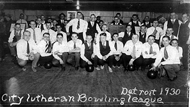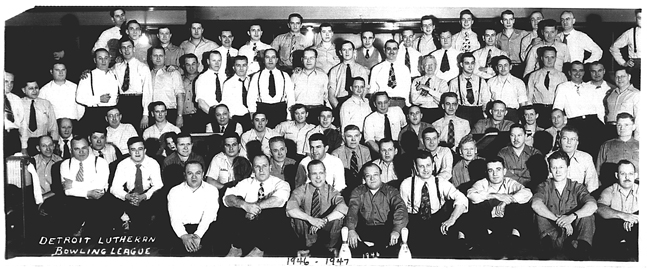Detroit league turns 100
October 07, 2011

The world Earl Richter knew when he joined the City Lutheran Bowling League in 1946 was a place where people were eager for a return to normalcy as they put another world war behind them. A bowling league seemed like a great way to start.
Now, at age 83, Richter is by far the longest-standing member of a league filled with people whose families have bowled it for as many as four generations.
“Now when I am bowling and people ask me ‘Well, how are you doing?’ I say ‘I am throwing the ball down the alley and hoping for the best,’” Richter jokes. “These days, I bowl to finish."
The Lutheran league was 34 years old when Richter joined. Founded in 1912 in Detroit, the league has convened every Thursday night for the past 99 years.
“Right now we have 18 teams and all of them are still named after Lutheran churches in the Detroit area,” says league president Mark Minda, who has bowled the league since 1977. “It started as a church league in 1912, when churches used to have bowling leagues in their basements because they didn’t want the bar and billiards associated with their church."
The league’s days in the basements of Lutheran churches are well behind it now, and it has called many bowling centers home over the years, but it seems poised to go on for centuries to come.
“The league has a really rich history in the area,” Minda explains, “not only because it has been around for so long, but also for being a place where your family bowls for generations.”
It also is known for being a place where bowlers show up for the fellowship, not the money. The prize fund allows for bowlers to earn no more than $2 per point.
“It’s been that way for 50 years,” Minda says. “That hasn’t changed.”
What has changed over the past 50 years, though, is everything else. People still sent letters in the mail back when Richter first shoed up for the Lutheran league 65 years ago, and the local church still rivaled the living room TV as a place where families gathered.

“The television wasn’t really up to date at that time, so a lot of your activities revolved around the churches,” Richter explains. “Churches had their own basketball teams and baseball teams, and a percentage of them bowled the league.
“At the old Concordia church we had a real close relationship with everyone, so we picked up bowlers through the years. The big thing for the league back then was that it was Lutheran. That makes a difference, when you’re bowling with people who all have the same religion.”
As circumstance scattered local Lutherans around the country and the church receded from its role as the pulse of the community, the league relaxed its eligibility rules to allow people to bowl even if they are not members of the church for which their team is named.
“It would be pretty hard to fill the league with all Lutherans today,” Richter says.
It may be easy to look back on the days when people bowled league in church basements as a simpler time when life moved at a slower pace. But Richter, who worked as a pin boy at a time when a game of bowling set you back a quarter and a bowling ball cost about $12, is not so sure.
“Back when you had pin boys and manual scoring you could bowl three games in a couple of hours,” Richter says. “But today with automatic pinsetters you have problems where the racks aren’t setting the pins right or you have to sit down at the computer and straighten out the score.
“When I bowled league last Thursday, there was one alley where the rack must have only had about 12 pins in it, because every time a guy threw a strike the next guy had to wait a long time. These are time-dragging things you never had before the automatic pinsetter.”
The game may look different than it did back when you could fill a whole bowling league with folks from church, but one thing has stayed the same: Every Thursday night since 1912, members of the City Lutheran Bowling League in Detroit tossed their ball and shoes into the car and headed to the bowling center for a few games with friends.
“Our league felt that this 100th anniversary needed to be celebrated because it has families who have bowled it for 70 years or more,” Minda says. “The entire league has the same bowling shirt. It says ‘100th Anniversary’ on the back, and I think it’s pretty special.”
Now, at age 83, Richter is by far the longest-standing member of a league filled with people whose families have bowled it for as many as four generations.
“Now when I am bowling and people ask me ‘Well, how are you doing?’ I say ‘I am throwing the ball down the alley and hoping for the best,’” Richter jokes. “These days, I bowl to finish."
The Lutheran league was 34 years old when Richter joined. Founded in 1912 in Detroit, the league has convened every Thursday night for the past 99 years.
“Right now we have 18 teams and all of them are still named after Lutheran churches in the Detroit area,” says league president Mark Minda, who has bowled the league since 1977. “It started as a church league in 1912, when churches used to have bowling leagues in their basements because they didn’t want the bar and billiards associated with their church."
The league’s days in the basements of Lutheran churches are well behind it now, and it has called many bowling centers home over the years, but it seems poised to go on for centuries to come.
“The league has a really rich history in the area,” Minda explains, “not only because it has been around for so long, but also for being a place where your family bowls for generations.”
It also is known for being a place where bowlers show up for the fellowship, not the money. The prize fund allows for bowlers to earn no more than $2 per point.
“It’s been that way for 50 years,” Minda says. “That hasn’t changed.”
What has changed over the past 50 years, though, is everything else. People still sent letters in the mail back when Richter first shoed up for the Lutheran league 65 years ago, and the local church still rivaled the living room TV as a place where families gathered.

“The television wasn’t really up to date at that time, so a lot of your activities revolved around the churches,” Richter explains. “Churches had their own basketball teams and baseball teams, and a percentage of them bowled the league.
“At the old Concordia church we had a real close relationship with everyone, so we picked up bowlers through the years. The big thing for the league back then was that it was Lutheran. That makes a difference, when you’re bowling with people who all have the same religion.”
As circumstance scattered local Lutherans around the country and the church receded from its role as the pulse of the community, the league relaxed its eligibility rules to allow people to bowl even if they are not members of the church for which their team is named.
“It would be pretty hard to fill the league with all Lutherans today,” Richter says.
It may be easy to look back on the days when people bowled league in church basements as a simpler time when life moved at a slower pace. But Richter, who worked as a pin boy at a time when a game of bowling set you back a quarter and a bowling ball cost about $12, is not so sure.
“Back when you had pin boys and manual scoring you could bowl three games in a couple of hours,” Richter says. “But today with automatic pinsetters you have problems where the racks aren’t setting the pins right or you have to sit down at the computer and straighten out the score.
“When I bowled league last Thursday, there was one alley where the rack must have only had about 12 pins in it, because every time a guy threw a strike the next guy had to wait a long time. These are time-dragging things you never had before the automatic pinsetter.”
The game may look different than it did back when you could fill a whole bowling league with folks from church, but one thing has stayed the same: Every Thursday night since 1912, members of the City Lutheran Bowling League in Detroit tossed their ball and shoes into the car and headed to the bowling center for a few games with friends.
“Our league felt that this 100th anniversary needed to be celebrated because it has families who have bowled it for 70 years or more,” Minda says. “The entire league has the same bowling shirt. It says ‘100th Anniversary’ on the back, and I think it’s pretty special.”





